Are hippos omnivores or herbivores? Hippopotamuses have very compelling food habits.
These African natives live in streams & rivers with tender grass on the nearby lands. They absolutely love their veggies. Both common & pygmy hippos are entirely dependent on vegetation. Hippopotamuses can show carnivorous behavior at times when food is insufficient.
There exist a dozen reports from southern Africa stating carnivore hippopotamus sightings.
Some rare sources also claim to have seen hippos feasting on the carcass of their own species. Though their stomachs are designed to digest plants only. Eating too much meat can make them sick.
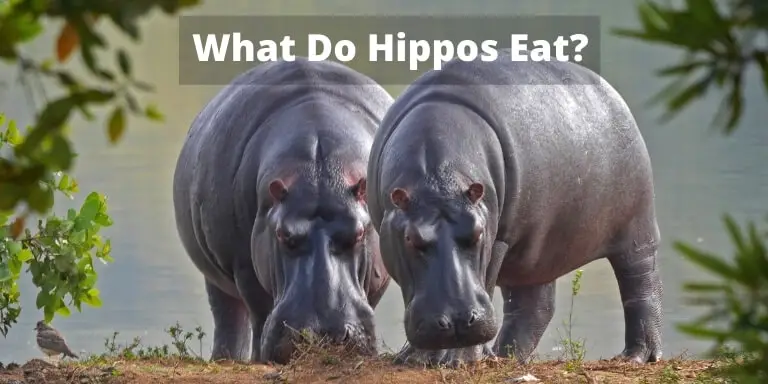
Division due to dietary
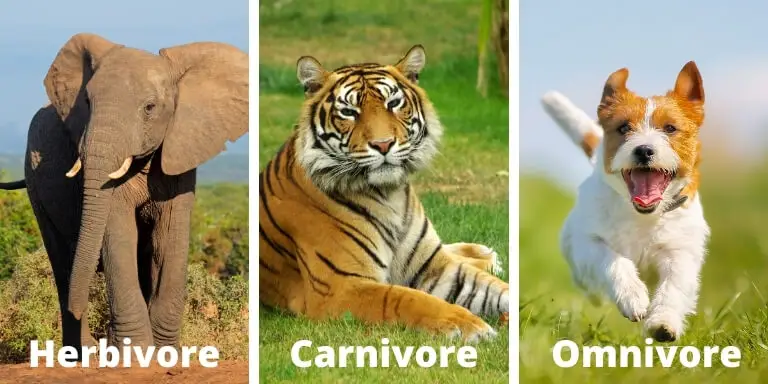
Animals can be divided into three groups based on their diet – herbivores, carnivores & omnivores. Those who live on plants or food from similar sources are known as Herbivores.
These animals are the ones that carry the energy of the green plants into the food chain.
They can range from tiny insects to the largest elephants.
Herbivores depend on vegetation & have stomachs able to digest only plants or grass. Many of them even have multiple chambered stomachs to assimilate the food faster.
Herbivores normally have flattened teeth for mincing the plant-based food. Many herbivores specialize in eating any specific part of a tree. Such as leaves, barks, fruits, berries, nectar, aquatic plants, roots, wood, etc. Some even eat dead plants.
Those who need meat for living their lives are called Carnivores. This category includes cats, hawks, snakes, bats, wolves, lions, tigers & the list goes on. Their nature is mainly to hunt & feast on herbivorous animals. Their teeth are sharp & pointy for tearing meat. They have digestive systems capable of breaking down animal protein.
The animals who can successfully eat & digest both veg & nonveg food are called omnivores. Humans are omnivorous beings. So are sharks, bears, dogs, raccoons & pigs also included. Bears catch fishes in streams but they also crave berries. They have both flat molars & sharp incisors in their mouths to be able to chew on the food from all sources. Some omnivores such as chickens don’t have any teeth. They simply swallow their food.
The omnivorous digestive tract is capable of breaking down both plants & animals. But unlike herbivores, not all kinds of plants can be dissolved in their stomach. Such as humans can’t digest grass or any other plant with cellulose in it. Some omnivores can hunt their prey like predators such as raccoons. Others may eat dead animals found nearby such as bears
Are hippos omnivores or herbivores?
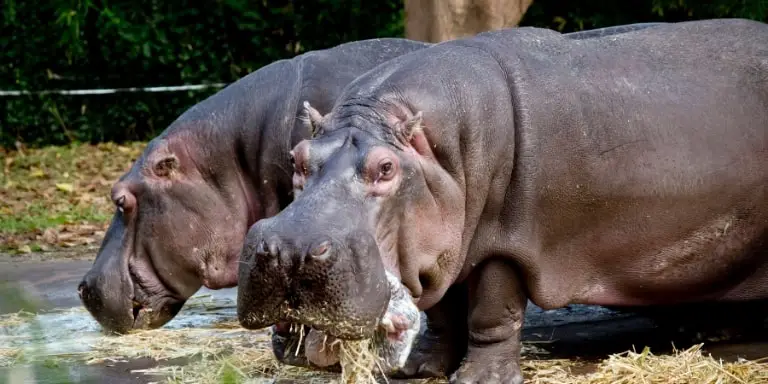
In the case of hippos, they’re principally vegetarian creatures. The barrel-shaped giants depend on the minerals found in plants. Their stomachs are even designed in such a manner. They’re territorial creatures but not so much when it comes to the case of food. Food is equal for all.
But often they can kill the weaker ones in the community to increase food share.
After sunset, they come out of the water. Hippopotami follow a grazing lifestyle. Small tender grass is a hippo’s favorite food. They also like tiny green shoots. They look for short grass or paddy fields along the riverbanks. Such areas are known as “hippo lawns”. They grab the grass with their lips & tear it using a certain motion of their heads. Hippos have very long teeth but those of the front aren’t used to grind grasses. The teeth in the back are used mostly. They usually like to just swallow the food without too mincing. Males like to move their tails vigorously during defecation to mark their territory.
Each day Hippos can eat up to 1% or 1.5% of their body weight. The semiaquatic cows can devour 40 kg (88 pounds) of vegetation per night. Every night they eat for about 5 to 6 hours.
The Diet of the pygmy hippos is somewhat more interesting. They are natives of the rainforests of West Africa. Their adaptations are as per the rain forest allows them to. They like to eat grasses, leaves, or ferns found near rivers or streams, or swamps. They mostly eat after sunset & spend a hell of a time underwater. They like to have berries or roots found in the jungle.
The bigger Hippos don’t eat humans. But that doesn’t mean they can’t squash people to a pulp. They’re very aggressive & kill about 500 men per year. Common hippopotamuses are sometimes seen chewing on aquatic plants. Their aquatic meals include lily pads. They also very much like hyacinths. They may eat 200 to 300 pounds of hyacinth a day. But these aquatic plants don’t cover the major parts of their huge menu.
However, the zoos feed these massive creatures a handful of meals. Most of the zoos are situated far from the natural habitat of the species. This affects their food habit in many ways.
However, hippos are adaptive beings. Their food habit in captivity change according to their surroundings.
Hippos aren’t picky eaters like most herbivores. They would pretty much devour anything that is plant-based. Their captive diet might include straw, lettuce, vegetables & pumpkins. They may also get bamboo, grain, hay, cucumber & yellow squash for dinner. Some zoos provide them with dehydrated beet pulp also. Occasionally they are fed watermelons & other fruits of a similar category.
Hippopotami have most of their meals at night. After sunset, they start coming out of the water singly or along with their calf. A mother hippo can go for several days without leaving the water & without food. She waits for her newborn to gain ample strength otherwise the bigger males may attack.
In the morning they go back to the water & stay submerged for about 16 hours daily. They like to stay inactive for most of the day. This act keeps their bodies moist & helps them digest the huge amount of food they devour.
A hippo can store several days (around 2) of vegetation in their stomachs. They can also survive without food for up to three weeks. Hippopotamuses have a low metabolic rate. For this, they can survive a long time without food. This characteristic of their body helps them survive the mean dry seasons of Africa.

How often do hippos have their non-veg meals?
During drought & scarcity of food, Hippopotamus may seem to tend to meat. As the greens are not available at the times, they don’t seem to have much of a choice. But flesh wouldn’t cover a significant part of their diet. During the not-so-dry-season, they’d choose anything but meat to eat.
Though the species are not hunters, they seem to attack kudus, impalas, or buffalos. Some reports exist of them feeding on zebras, elephants & wildebeests also. They generally tend to steal the hunt of other predators. This act of carnivory is mainly to supplement their need for nutrients.
Their abusive nature is seen in captivity also. Existing reports state hippos attacking their neighboring animals in zoos. Those include tapirs, flamingoes, pygmy hippos, etc.
Hippopotami & crocodiles coexist in the wild. Though hippopotamuses don’t eat crocs, they might attack at times if intimated. Their massive size makes them almost immune to predator attacks. They may even turn on the corpse of their species. Occasionally these giants may also eat insects.
The semiaquatic beasts don’t like fish on their menu. But very few reports exist of common hippos eating fishes. Scientists generally describe such acts as aberrant & results of excessive stress.
Are hippos cannibals?
Cannibalism in the animal kingdom isn’t a rare occurrence. Animals may show cannibalism for a number of reasons. The hippos, though being a herbivore species, were surprisingly caught in such heinous acts.
Only two confirmed reports exist of hippo cannibalism. The most recent incident was reported by a Ph.D. student of Imperial College London, Leejiah Dorward. Mr. Dorward was on safari in the Kruger Park of South Africa. To his amazement, he caught the hippopotamus red-handed & decided to capture a photograph of it. Till then there existed only a single confirmed cannibalistic report of hippos from 1999 before his.
Mr. Dorward learned that it is not so common for hippos to act likewise. Both incidents had something in common & that is famine. As this is a rare occurrence, scientists are still waiting for more reports for further research.
Physical adaption of hippopotami
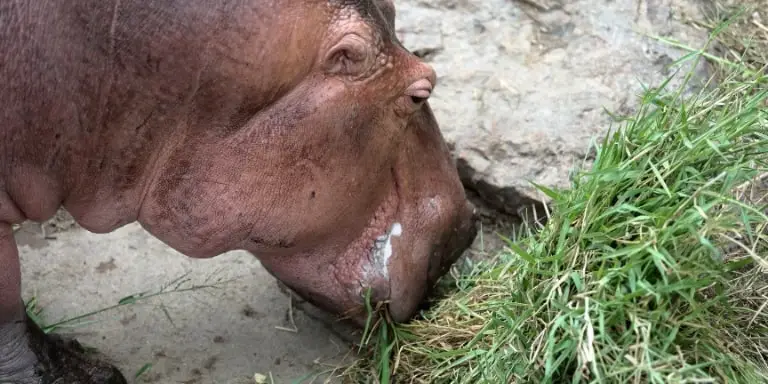
Hippo’s physique is a unique one in the animal kingdom. These oversized beings have concurred the rivers & canals of Sub Saharan Africa. Many scientists find it to be surprising that a grass-eating mammal can grow up to such portions. Their bodies have adapted to grass eating through millions of years.
Lips: Their lips are massive & the inside of the mouth is spacious. They use their lips to tear grasses & chew using the teeth in the back.
Teeth: They have the largest teeth among the land mammals. Their incisors can grow up to 1.2 feet & the canines can even outgrow other ones having a surprising length of 1.5 feet.
The jaw hinges are situated far away in the back allowing the giants a gape of about 180 degrees. Front teeth are generally used in encounters with other species & the back teeth are used for food grinding.
Stomach: The hippos’ stomach consists of three distinguished chambers. It’s sort of a three-chambered fermentation factory. The stomach is designed to derive the most amount of nutrition from the vegetation they eat. Hippopotami have longer intestines than other herbivores. This allows them to perform heavy digestion for a longer amount of time on all plants.
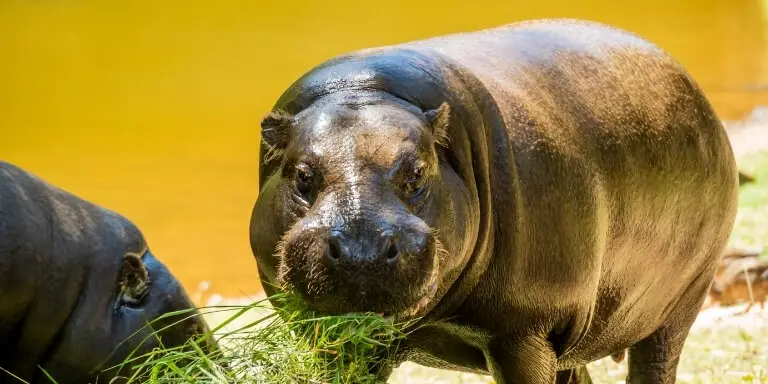
Feeding of baby hippos
A pregnant hippo gives birth to a single calf after a gestation period of about 8 months. Babies are either born on land or in the water as per the mother’s wish. The mother can wait up to two weeks for their newborn to gain enough strength to return to the herd.
Babies are terribly dependant on the mother’s nurturing. The mother takes care of the calf for about 8 months. The calf can eat grass after around three weeks. But they are dependant on breastfeeding for six to eight months. Babies & moms always sleep together. Female babies grow to be mature faster. Male adults however weigh around 30% more than females.
In zoos, the calves are fed initially with mother’s milk. Gradually they are introduced to more complex food. Fiona the baby hippo in Cincinnati Zoo is fed with her mother’s milk & some formula. Then pre-chewed hay was introduced to her. Next came the mushy grain. A cup of which she had every day.
Hippopotamuses in the animal food chain
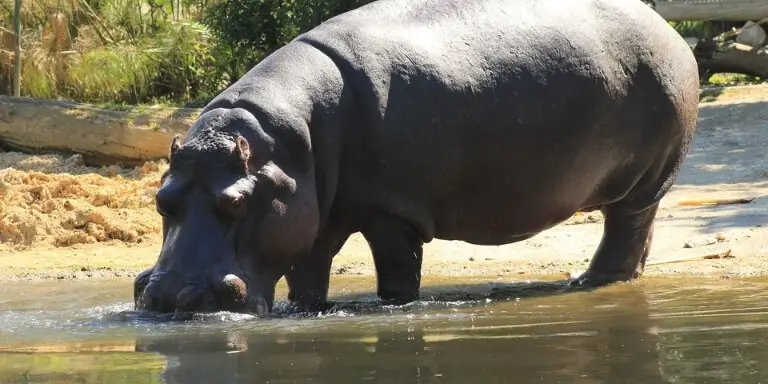
Hippopotami play an important role in the food chain. Though they aren’t often attacked by predators, due to their excessive appetite for the grass they’re classified together with other herbivorous species. They act as a transition & carry the bioenergy from the plants to the animals. Carnivores then feed on the herbivores & the energy cycle continues.
Conclusion
That was pretty much everything you needed to know about a hippo’s diet. Please don’t forget to share our article & let us know what you think. What have you found most interesting about their eating habits? Or what have you found most disgusting about it? Thanks a lot for sticking with us.
Related Posts:
Hippo Life Cycle | How Long Does A Hippo Live?
Can You have a Pygmy Hippo Pet?
How to Survive a Hippo Attack | Tourist Survival Guide
Why Does Find a Hippo Mouth Open? Let’s Explore
